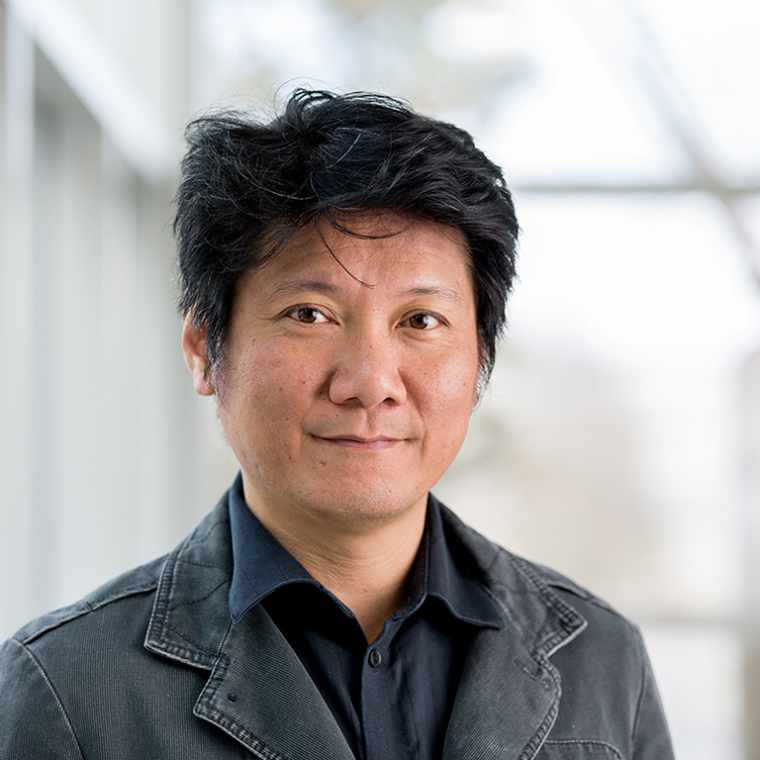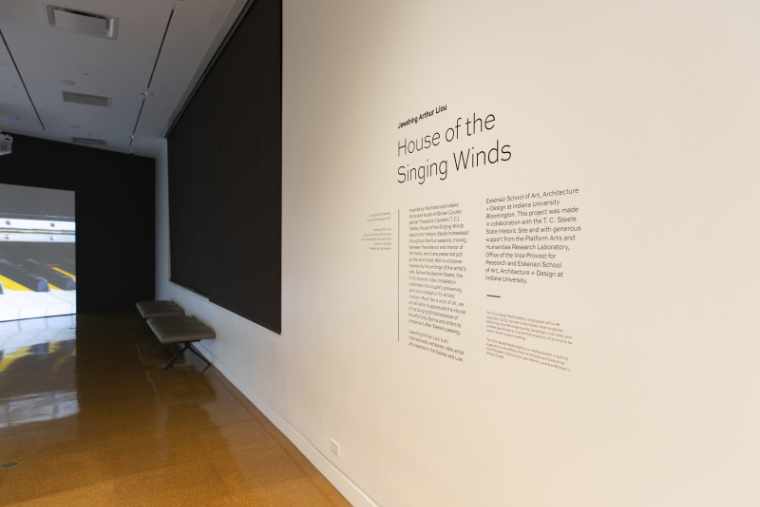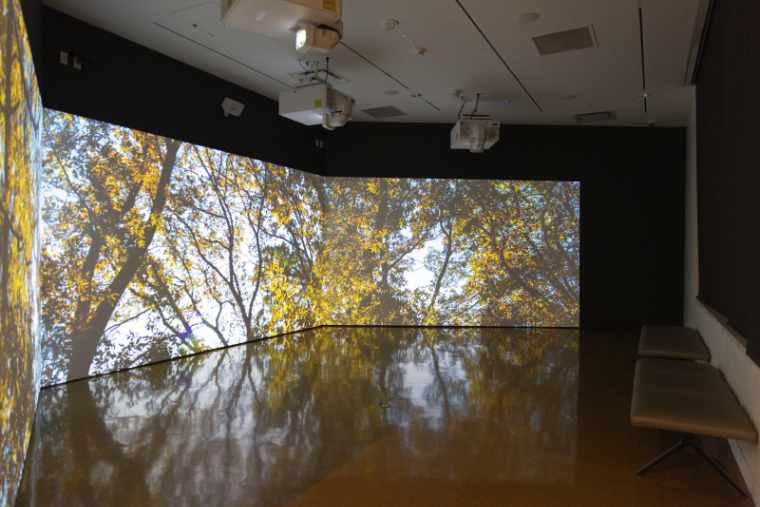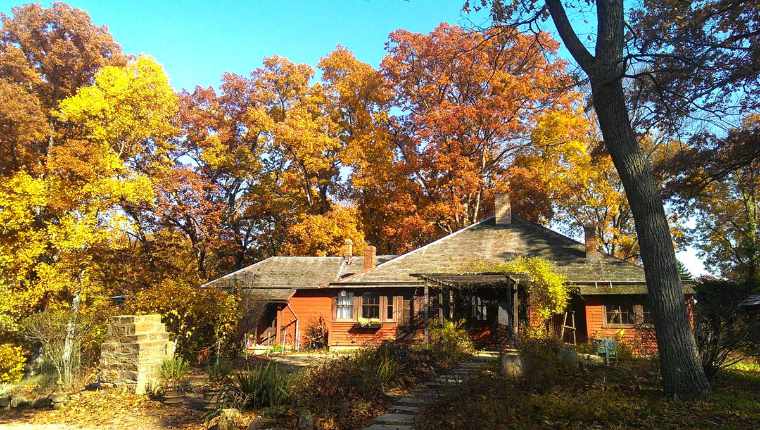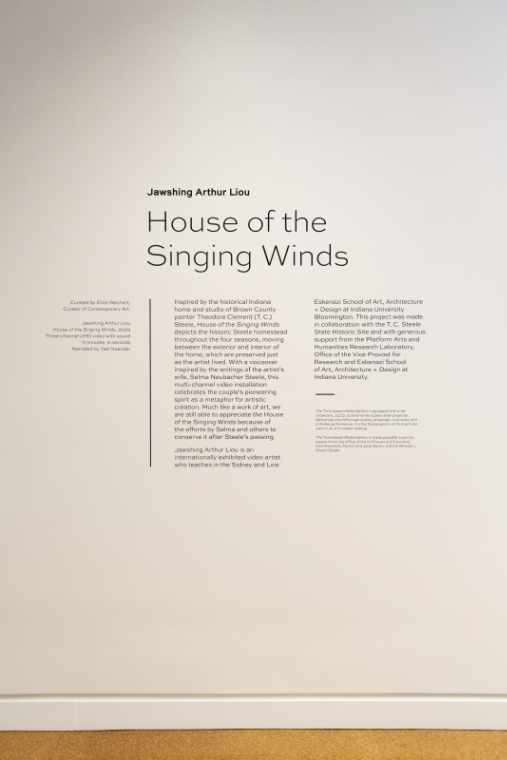Jawshing Arthur Liou has a background in photography, digital media, film, and journalism. Liou works with lens-based materials and electronic imaging to create installations depicting mental and surreal spaces. Many of his videos do not contain clear narratives but are meditative in nature. Using sources ranging from landscapes and oil paint to human body, much of Liou’s work is related to notions of impermanence, human tragedy, and spiritual sanctuary.
As the first artist to install a video project into the newly minted contemporary video gallery, Liou’s immersive artwork, “House of the Singing Winds,” takes viewers on a visual journey of the historical Indiana home and studio of painter T.C. Steele.
“When the audience approaches the studio, they first hear music, a calming female voice from a distance. Once they turn the corner, they see light in a darkened space. But the light immediately puts them outdoors. We’re transporting viewers to nature and then the interior of T.C. Steele’s house that was built a century ago. They hear the story contemplating on the artist’s life through shots of the landscape he loved. Through images of the intimate details of the house, we’re able to imagine the way they lived and in turn, viewers perceive a story of affection, love for nature and for each other,” said Liou.
Scale and immersion are important considerations of Liou’s art, and it requires state of the art projection to bring it to life properly. Part of what Liou was trying to achieve in terms of immersion also defied most projectors’ capabilities prior to Epson, that is the ability to view and experience projected art from a very close proximity without perceiving pixilation. In addition to that, his ambitious vision included at least three channels of 4K video to achieve the effect he was attempting in his work.
“In the old days, you get close to a projected screen and you see pixilation, so resolution has been an important factor for this medium,” said Liou. “From there on, we’ve been envisioning 4K projection in a three-screen setting to achieve a certain level of clarity and a sense of immersion. But there were bumps along the road. At one point, the university was thinking about cutting the studio space to only two projectors, and I was really stunned because I had been filming three channels for about a year when they broke that news. Fortunately, we returned to the original plan and were able to install three projectors that are far superior to my imagination.”
In discussing the nexus of his composition, “House of the Singing Winds,” Liou remembers when he was first made aware of T.C. Steele’s house and the history it presented. He had been driving through the T.C. Steele site and was not aware of its history and significance. In 2009 he realized it was a historic site about an Indiana painter and while Liou is not a painter, he wanted to try and achieve a video project that possessed a similar material quality to painting. This was yet another reason why having such amazing resolution gave him a big advantage to achieve the sense of reality that people perceive from paintings.
Almost a decade later, Liou and Brenneman, discussed the idea of executing the T.C. Steele video installation in the new studio space being designed in the Eskenazi Museum of Art.
“So I decided to visit T.C. Steele’s house and film the historic home. It was built in 1907 and the majority of the interior objects in the house were original. We were looking at a time capsule, from books to lights to antiques, that provided the type of texture that is a dream for a cinematographer,” said Liou. “It was full of potential, but I was filming with a really awkward style. Originally, I was shooting one screen at a time and trying to set the shots up in proximity to one another and hoping they’d connect. Most of the time they didn’t, so that was one of the reasons early progress was extremely slow.
Since everything in the house is static, Liou eventually decided to film with one camera so he could move more effortlessly inside the house and create a sense of motion where none existed. However, even with this movement, there is no single video camera that can capture the amount of resolution that three 4K projectors could deliver. To overcome this problem, Liou invested in a new camera that could shoot 10,000 pixels still photo horizontally, which would cover most of the pixels he’d need to fill the three-screen panorama. However, since a photo is static, he used stop motion animation technique to compose the video and make it look as though viewers are moving fluidly through the house and grounds. In this process, Liou had to shoot still files using a motorized slider. Incremental movement was made after each shot in a way that simulates a video sequence. It usually takes a set of 300 shots to generate 10 seconds of usable footage.
“I had to wear a field monitor, mask it down to only use the middle very thin stripe to get a feel of what I was capturing. It was still guesswork. The monitor was only seven inches, so I kind of had to translate it in my imagination to three projections in the space,” said Liou.
However, the end result of Liou’s painstaking stop motion animation is a gorgeous contemporary video installation, using every inch of available screen space and power of the new Epson 4K projectors to produce something truly unique and beautiful. While it took “many miracles” to bring this work together according to Liou, the museum and all involved are proud of the existing work and excited for the future of the new installation.
While Liou’s upcoming video projects were put on hold due to COVID-19, there are a few exciting projects on the horizon, including a first-person visual story depicting the journey across the Southern border of the United States and the evolution of human relationship with cannabis.
“I feel really fortunate to be able to work in the medium that is constantly evolving. Thanks to the rapid development in the projection industry, we’re able to extend our vision almost at a warp speed,” said Liou. “This is one medium that will only look better over time because you can continue to present an existing image with higher image quality. There are few artforms that mature over time like fine wine, but it is something really unique about projection technology.”
“The area of video art is an important artistic medium right now with a really rich history and strong forward trajectory. For this space, it was about taking a medium that is well established and pushing that even further,” said Reichert. “This projection application made the most sense for us and I’m really excited for the opportunities this space will provide artists. I’m especially looking forward to seeing how artists respond when they discover it has the ability to deliver the high-level standards of what they visually imagined when producing their artwork.”
*In order to help support the project, Epson donated an ELPLX02 Ultra Short-Throw lens.

